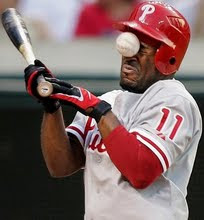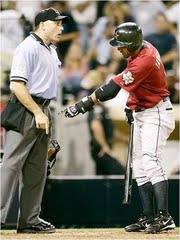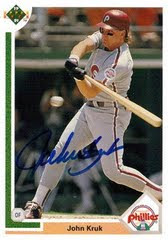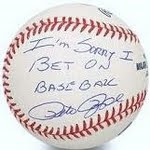All stats are current through Monday, May 23.
Eight weeks in to the 2011 baseball season, and Bud Norris is no longer "flying under the radar." Through his first nine starts (55 innings pitched) of the season, Norris is supporting a disgusting 64 strikeouts (27.6 percent strikeout rate, fifth-best amongst all major league starters) to a mere 20 walks (8.62 percent walk rate, on par with perennial Cy Young candidates Tim Lincecum and Josh Johnson) for a strong 3.20 K/BB ratio.
He is also getting more groundball outs (44.7 percent) than flyball outs (38.3 percent), sporting a 1.17 GB/FB ratio and 80.8 percent GB/AO ratio. Norris' peripherals (3.38 FIP, 2.84 xFIP, 3.50 tERA, 3.34 nxFIP*, and 1.21 xWHIP) are quite strong, but his results to date in more traditional metrics have not been too shabby, either (3.91 ERA and 1.31 WHIP, though in "the year of the pitcher," such stats rank 93rd and 89th, respectively, out of the 169 starting pitchers with 10-plus innings pitched in 2011).
*nxFIP stands for normalized xFIP. It is calculated similarly to xFIP, only a pitcher's line drive rate is normalized to 19 percent, with his residual balls in play being distributed based on the pitcher's groundball to flyball and outfield flyball to infield flyball ratios. Once the normalized outfield flyball total is calculated, I multiply this figure by one-half the pitcher's home park park factor for home runs per outfield flyball rate times 11.5 percent.
Noting this dominance to date this year, and highlighting that Norris was hardly an "unknown" entering the season after last year's well-publicized 158 strikeouts (9.25 K/9, eighth-highest in the major leagues among starters with 150-plus innings pitched) and 77 walks (18th-highest walk total in the majors last season amongst all pitchers) over 153.2 innings, why is Norris not owned in even half of Yahoo leagues (46 percent ownership)?
More curiously, why is Norris owned in just over half as many leagues as his fragile American League clone, Brandon Morrow (82 percent Yahoo ownership). It's not like Morrow (5.06 ERA, 1.44 WHIP) is exactly lighting the world on fire.
First, let's look at how the two pitchers are similar. Here are each's peripherals (and the major league average for each category) on the season:
| Player | K% | BB% | SwStr% | F-Strike% | Contact% | GB% | FB Velocity | Slider% | FIP | xFIP | xWHIP | wOBA-against |
| Bud Norris | 27.6% | 8.6% | 12.0% | 62.5% | 73.0% | 44.7% | 92.6 MPH | 37.6% | 3.38 | 2.84 | 1.21 | .313 |
| Brandon Morrow | 30.3% | 10.6% | 12.4% | 64.8% | 72.5% | 32.9% | 93.4 MPH | 24.7% | 2.12 | 2.97 | 1.28 | .288 |
| MLB Average | 17.9% | 7.8% | 8.4% | 58.9% | 80.9% | 42.2% | 91.7 MPH | 15.1% | 3.80 | 3.70 | 1.34 | .312 |
And for their careers:
| Player | K% | BB% | SwStr% | F-Strike% | Contact% | GB% | FB Velocity | Slider% | ERA | FIP | xFIP | xWHIP |
| Bud Norris | 23.7% | 10.5% | 11.2% | 57.0% | 74.8% | 42.0% | 93.5 | 34.7% | 4.63 | 4.13 | 3.80 | 1.36 |
| Brandon Morrow (as SP) | 26.1% | 11.6% | 11.1% | 54.4% | 74.9% | 37.9% | 93.7 | 15.4% | 4.54 | 3.64 | 3.82 | 1.42 |
Both pitchers stand out as big strikeout pitchers for their career (posting top-10 SwStr% rates of any starting pitcher between 2007 and 2011) with large walk rates to boot (a combined 339 batters walked over just 640.1 combined innings pitched (4.76 BB/9, 12.1 BB%)).
Each is right-handed, throws a good number of breaking balls (particularly the slider), and each throws hard. Morrow has proven to be a bit more of a strikeout pitcher than Norris for his career, but Norris makes up for that with more groundballs.
There is a difference in their career and 2011 FIPs, but some of that might be HR/FB% luck, as each pitcher has near-identical xFIPs for their career and on the year.
Morrow and Norris have comparable fastball velocities as starters, and hitters similarly struggle to make contact against their pitches. Norris tends to throw more (and a lot of) breaking balls (particularly sliders) than Morrow, which is clearly a red flag for his long-term health, but it is not exactly as though Morrow is a model of health himself, having been on the DL at least once each of his pro seasons (not to mention the fact that Morrow also has diabetes). Both pitchers are also about the same age (26-ish), with Morrow being Norris' senior by less than a year.
Both tend to fair worse against lefties, but only Morrow's career split (4.57 xFIP versus LHB, compared to a 3.48 xFIP versus RHB) stands out as significant (Norris' career LHB/RHB xFIP split is 4.00 to 3.63), but Morrow's struggles against lefties have lessened in recent years (3.87 xFIP versus LHB in 2010, 3.12 in 2011).
Hence, for all intents and purposes, we have two identical pitchers. Yet one is owned in less than half of fantasy leagues out there, while the other is almost universally owned.
That is mind-boggling, especially when you consider that not only does Norris play in the NL, meaning that about 10 percent of his opposing batters tends to be pitchers, but he plays in the weakest division in baseball, the NL Central, which, although he cannot face his own team, still nonetheless features the below .500 and offensively-inept teams that are the Pirates and Cubs (sad face) in a disproportionate number of series. Compared this to Brandon Morrow, who faces three of baseball's most fearsome offenses in the Boston Red Sox, Tampa Bay Rays, and New York Yankees in a disproportional number of games.
Yet Morrow, modern strikeout champion of the almost no-no crown, has brand power, while Norris toils away on the shelf like a generic-label product that is also manufactured by the brand-name producer. It makes you wonder why Dallas Braden did not get any kind of love heading into the season (yeah, yeah the whole foot nerves thing, we get it).
Noting this all, what does it mean?
It means that you can get a hefty return for Morrow, trade less than that away for Norris, and come away with a relative profit that improves your team overall while maintaining the same level of production in mixed leagues.
Brand name is a large component of arbitrage in fantasy baseball. Players with less hype and less of a track record of success, including breakout players, tend to have lower trade values than established or hyped players. This is why it is so hard to "buy low" and "sell high" most of the time.
On the flip side of that coin, however, is the "sell low" and "buy high" strategy. It may seem anachronistic, but selling low or at market on hyped guys and buying low on players that owners tend to be cautious with can net you a large profit because such deals tends to maximize the value you receive while relatively minimizing the cost you have to pay.
Take, for instance, the cost of acquiring Jose Bautista last year. I went on record early and often in last year's AL Waiver Wire and other fantasy columns noting how much I believed in Bautista's pull power in the Rogers Center. I never thought he would hit 50 homers from the beginning, but I bet a friend in May, 2010 that he would hit 30 and tried to up the ante, double or nothing, to 40 around the All-Star Break.
Most Bautista owners wearily plucked him off the wire last season and were cautious to play him. On one hand, you gotta ride the hot streak, but on the other, "This is Jose frickin' Bautista we're talking about."
You obviously could not have acquired him for free, as a "toss in" or for a fungible bench player, but compared to the value produced by Bautista each month last season, you could have acquired him for pennies on the dollar. In one of my primary leagues last season, I traded away Jay Bruce plus Dan Uggla in May to get Bautista and Martin Prado.
The unknown is scary, but fear has a deprecating effect on value that you can intelligently exploit to your advantage. Think of it as buying junk bonds. People are afraid of owning them as an investment vehicle, but they're less risky than common stock.
That's why I like to invest heavily, albeit at a discount, in players like Michael Pineda and Brandon Beachy either on draft day or early in the season (though sometimes, as in the case of Kyle Drabek (who I, thankfully, was able to universally flip for Ryan Dempster after his 0.1 inning disaster at Chase Field), you just lose).
The end of May brings the beginning of real trading season in fantasy baseball. For the first six to eight weeks of the season, owners tend to be patient, opting for waiver wire moves, "waiting it out" and minor trades over major/big-name trades to fill team holes. It is not really until you reach the 50-game mark that a team's "needs" becomes readily apparent. Owners are cautious to avoid conflating "need" and poor construction with bad luck. Accordingly, this is what I recommend.
First, trade Morrow. With a 5.06 ERA and 1.44 WHIP on the season, this may be a harder task than it was in the preseason, but Morrow's AL-leading 12.09 K/9 (second-best in the major leagues) and enticing peripherals will lure plenty of owners to bite if you going trade fishing. Morrow, thanks to Josh Shepardson and the boys at ESPN, was a hype machine this offseason, and I guarantee you that you overpaid for what Morrow is capable of doing on his own merit.
I almost guarantee you as well that, despite what you paid for Morrow (unless you ridiculously overpaid for him), there is an owner out there willing to relieve you of your investment at cost (or better). Enough people understand FIP to think they would be buying low on an ace.
But why trade Morrow? His FIP, xFIP, and tERA are all under 3.00 this year, and he is a strikeout god. The answer is in his control. Much of Morrow's preseason hype came as a result of his second-half recall on free passes issued. Over his final ten starts of the season (56.1 innings pitched) before getting shut down, Morrow only walked 22 batters, good for a 3.51 BB/9.
That was a marked improvement over his career walks-per-nine rate (north of 5.00), but it came at the expense of fewer first-pitch strikes than either his career or first-half averages. First pitch strikes tend to be half the battle in walk rates for pitchers, and a 56-inning sample is hardly a reliable enough sample size to discount umpire luck or some other element to blame other than truly improved control. Furthermore, Morrow's current walk rate (4.22 BB/9) represents a large step back from last year's second half "improvement."
At the same time, Morrow's peripherals, while impressive, may not truly be as notable as they currently look. If we ignore Morrow's season debut (5.1 innings pitched, 10:2 K/BB ratio), his strikeout rate on the season falls from north of 30 percent to 27.0 percent on the dot, or a batter per nine innings. Likewise, his walks-per-nine rate would increase to 4.38.
A 27.0 percent strikeout rate (11.1 K/9) is hardly something to sneeze at, but if we also regress Morrow's current 2.9 percent HR/FB rate to his career rate of 8.1 percent (I do this cautiously, rather than regress his HR/FB rate towards the major league average of 10.5 percent*, as there is an as-yet-unproven theory that power pitchers can outperform league-average HR/FB rates), his FIP rises from 2.20 to the 3.50.
Of course, that is still solid, but if Morrow's control regresses any further, or if Morrow's groundball rate continues to float around what it was while he was in Seattle, his expected FIP could easily approach the 4.00 mark.
*League average HR/FB percent tends to be around 10.5, while HR/OFFB percent tends to be closer to 11.5.
More worrisome are Morrow's numbers if we plug in his 2011 stats, omitting his first start, into the lastest version of my xWHIP calculator (NOTE: I do not have runs-created values for 2011 offhand, so the tERA cell is set to 0.00):

Do not get me wrong; Morrow is clearly valuable and a pitcher worth owning that will do wonders for your strikeout rate. At the same time, however, he is a commodity whose current perception overshadows his actual and potential value. When a player has this kind of potential trade value above his expected value, he is a prime trade chip.
At the same time, I would recommend acquiring Norris for all the reasons to love Morrow, except he will cost you a fraction of what you'd have to trade away to get Morrow. Norris, like Morrow, has his control and injury-risk issues, but he racks up elite strikeouts and could conceivably pile up more total innings over the rest of the 2011 season.
Norris' peripherals show that he is just as likely to have taken that "big step forward" as Morrow, but the season is still young and his slowly-increasing army of owners might cautiously believe that they are just riding a hot streak.
Do not let anyone sucker you into believing that Norris is thriving off weak teams and favorable matchups. While it is true that his two worst starts came against two strong offenses in the early-hot-hitting Philly (April 3) and St. Louis last week (May 18), Norris still shut down those same Cardinals earlier in the season (6.0 innings pitched, zero earned runs, 6:2 K/BB ratio on April 26), and he obliterated Milwaukee at the beginning of the month (7.2 innings pitched, no earned runs, 11:3 K/BB ratio on May 1).
As the above indicates, Norris is not just a poor man's Morrow; he is the smart investor's Morrow clone. Both Morrow and Norris are elite strikeout sources who probably will not obliterate your WHIP or ERA (even in a season where some 40 starting pitchers (minimum 10 innings pitched) have sub-3.00 ERAs) on the merit of their relatively undifferentiated pitching talents. Neither pitcher is likely to win many games, Morrow because he tends to rack up high pitch counts and depart games early, and Norris because he plays for the offensively inept Astros).
One, however, probably has a trade value above market, while the other can be had at a discount. Earlier in May, I was able to trade away Brandon McCarthy and Luke Gregerson (whom I replaced with Sean Marshall) for Norris. If you offered that for Morrow, you'd probably be laughed out of your league. Yet, no one had anything to say about my under-the-radar move.
Would you trade away Morrow, or am I just crazy? If you would trade him, what kind of value would you need/do you think you could get in return? Sound off in the comments below.







0 comments:
Post a Comment